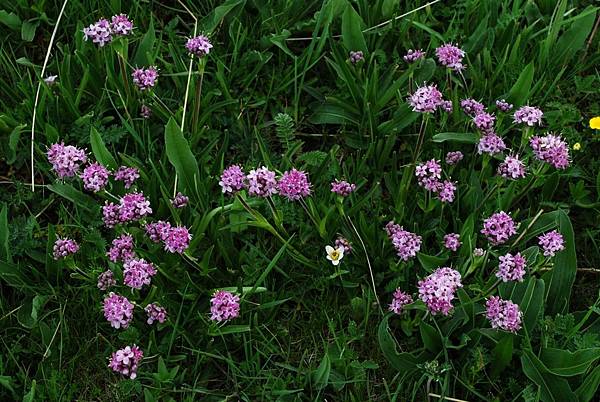穗甘松(Spikenard,Nardostachys jatamansi / Nardostachys grandiflora)
忍冬科(Caprifoliaceae)/ 敗醬科(Valerianaceae)甘松屬(Nardostachys)
學名:Nardostachys jatamansi / Nardostachys grandiflora
別名:muskroot

圖:穗甘松(Nardostachys jatamansi / Nardostachys grandiflora)
瀕危物種,分布從印度和巴基斯坦喜馬拉雅山區,到尼泊爾、西藏和中國的3300-5000 m海拔高處,灰深色的根狀莖散發異香,葉無柄似卵,開暗粉紅花[1-2]。
【生理活性】
尼泊爾的穗甘松根狀莖水蒸餾精油有1(10)-aristolen-9β-ol (11.6%)、白菖烯(calarene,9.4%)、纈草酮(jatamansone,7.9%)、valerena-4,7(11)-diene (7.1%)、甘松醇(nardol A,6.0%)、cis-valerinic acid (5.7%)和纈草醛(valeranal,5.6%) [3]。
巴基斯坦的穗甘松根部精油有[4]喇叭烯氧化物[II] (ledene oxide[II],13.021%)、 廣藿香醇(patchouli alcohol,9.582%)、[-]-匙葉桉油烯醇([-]-spathulenol,2.672%)、藍桉醇(globulol,1.876%)、4-[3,3-dimethyl-but-1-ynyl]-4-hydroxy-2,6,6-trimethylcyclohex-2-enone (1.849%)。
印度的穗甘松根狀莖精油組成是[2]纈草酮(36.71%)、α-杜松醇(α-cadinol,22.67%)、16碳烯酸乙酯(hexadecenoic ethyl ester,11.25%)、戊酸丁香酚酯(eugenyl valerate,4.72%)。
民俗療法
中世紀歐洲做為香料。阿育吠陀和尤那尼(Unani)醫學舉足輕重的藥草,藥用史追溯至古希臘、埃及、羅馬,橫跨印度、阿拉伯、尼泊爾、巴基斯坦、西藏、中國,以及伊斯蘭世界。巴基斯坦人用於治偏癱、貝爾麻痺症(Bell's palsy)和帕金森氏症[5]。印度次大陸區習慣添加精油到多種按摩油中[5-6]。常見添加入阿育吠陀藥方中,治失眠和焦慮,例如:Sarpagandha Ghan Vati和Brahmi vati [7]。也是阿育吠陀治療腦部異常用藥karpuradyarka 的成分之一[8]。[1、9]
根莖可刺激頭髮生長和增黑,治頭痛、躁動、停經症候群、脹氣、癲癇、黴菌病症、暈厥、神經衰弱、高血脂或腹痛,也用在消化、循環、神經、呼吸、泌尿和生殖系統疾病,以及皮膚相關病徵,例如燙傷、發炎,近期研究有朝開發成皮膚護理產品的趨勢。[1、9]
改善帕金森氏症
預先口服印度穗甘松根部95%酒精萃取物400或600mg/kg body持續3周,在第21天以藥物誘發大鼠腦部紋狀體(striatum)神經損傷,口服穗甘松酒萃物的大鼠所受到的神經損傷顯著較低[10]。帕金森氏症和中腦黑質(substantia nigra)神經核團的健康與否密切相關[11],黑質分泌的多巴胺藉由黑質-紋狀體路徑(nigrostriatal pathway)送至紋狀體調控我們的運動和平衡。穗甘松能有效抑制黑質內脂質的過氧化,且保留大量抗氧化物穀胱甘肽(glutathione),以及紋狀體的抗氧化酵素活性,例如:超氧歧化酶和過氧化氫酶,並維持大部分的多巴胺數,避免失衡衰退。
加速生髮
大鼠背部塗抹印度穗甘松根莖己烷萃取物2%劑量50 μl /4平方公分 持續30天,能有效增加生髮速度30%。純化出的成分寬葉甘松酸(jatamansic acid)、nardin和minoxidil也可分別加速23.3-43.3%[12]。
保肝
預先口服印度穗甘松根狀莖50%酒精萃取物800 mg/kg body wt持續3天的大鼠,能在誘發肝損傷時顯著降低其傷害,並提高存活率[13]。口服穗甘松的大鼠,就算經藥物誘發,血液中的肝臟相關酵素仍維持正常值,表示肝臟誘發後並未受損,因此酵素不會從傷口流進血液。
抗糖尿病
持續7日口服印度穗甘松根莖酒精萃取物400或1200 mg/kg的糖尿病大鼠[14],結果1200 mg/kg能有效降低血壓,400 mg/kg不顯著。第7天時,口服1200 mg/kg的大鼠血糖值從253降至96.3,和降糖藥—固利康錠(Glibenclamide)的85.6效果相當。
強心劑
大鼠誘發心臟病變前,預先口服印度穗甘松根狀莖95%酒精萃取物500mg/kg 持續7天[15],能預防病變導致的體重減輕、心臟重量下降和升高的心臟脂質過氧化值,維持正常值。進一步分析可發現,組織的抗氧化酵素濃度上升,且血液中因病變從組織流失到血液的酵素濃度也顯著下降。
抗癲癇、鎮靜
腹腔注射200-400 mg/kg印度穗甘松根部95%酒精萃取物的大鼠,可有效提高強直-陣攣型癲癇(maximal electroshock seizure)的發作門檻,一次性口服200-400 mg/kg或持續15天口服125 mg/kg也有同樣效果[16]。另在以安眠藥誘發的反射喪失試驗中,併服穗甘松能有效延長反射恢復時間,並呈劑量關係,顯見有鎮靜功效。
二苯妥因(phenytoin)是癲癇治療藥。穗甘松酒萃物可協同二苯妥因,提升藥效,大鼠研究指出2者併用毒性更低、藥效更好,且血液中二苯妥因濃度更高,這表示穗甘松除了保有自己功效,也能助二苯妥因協長補短,發揮協同效應(synergistic effect)。
增進記憶和學習力
持續8天口服印度穗甘松根部(roots)95%酒精萃取物200 mg/kg的年輕(3個月)或老年(7個月)小鼠[8],在高架十字迷宮和被動規避測試(passive avoidance paradigm)模型中能有效改善年輕小鼠的記憶和學習力,以及藥物誘發的健忘症;此外,也可翻轉因老年小鼠因老化導致的健忘。
高架十字迷宮中,第9天相較於控制組學習時間的19.3秒,年輕小鼠在口服穗甘松後減少到10.1;而藥物導致增加的學習時間31.7-38.6,口服穗甘松的年輕小鼠能將時間縮減至9.6-11.5。年長小鼠需32.1秒的學習時間,經口服穗甘松後降至9.1。同時,在另一被動規避測試模型也表現出相似實驗結果。
舒緩失落、焦慮
口服印度穗甘松根狀莖甲醇萃取物200或400 mg/kg持續10天的正常小鼠以及第9天被剝奪24小時睡眠的小鼠[17],在強迫游泳(forced swimming test)和懸尾(tail suspension test)憂鬱試驗模型中,皆表現出抗憂鬱反應,口服穗甘松的小鼠在實驗過程中靜止不動時間顯著降低。
可能風險
腹腔注射穗甘松95%酒精萃取物的大鼠LD50在569±20.8 mg/kg,不過口服1000 mg/kg並沒有使大鼠死亡,只是劑量越高就越趨於鎮靜狀態,口服500 mg/kg 時會產生37.5%神經毒性[16]。小鼠攝取3000 mg/kg的酒精萃取物也沒事[14]。
小鼠口服2000 mg/kg body weight穗甘松根狀莖甲醇或80%酒精萃取物,未觀察到任何急性中毒徵狀[14、17]。
【芳療功效】
吸嗅韓國穗甘松精油的小鼠[18],能有效抑制苯醌(phenylquinone)導致的腹腔壁扭曲和環戊四氮(pentylenetetrazol)誘發的癲癇,以及延長戊巴比妥(pentobarbital)的安眠時間,具有緩和疼痛、抗癲癇和鎮靜功效。使用的精油成分有白菖烯(calarene,36.4%)、9-aristolen-1α-ol (6.29%)、α-芹子烯(α-selinene,3.38%)、纈草酮(3.37%)。
doTERRA的實驗[19],穗甘松精油(0.0033%)在人類皮膚纖維母細胞實驗中,能抑制多種發炎因子和組織重塑(tissue-remodeling)相關分子,可能有抗發炎、傷口癒合和免疫調節等潛在功效。使用的精油組成含β-古芸烯(β-gurjunene,11.3%)、纈草酮(9.5%)、spirojatamol (8.7%)、6,9-guanidiene (7.5%)、瓦倫烯(valencene,5.6%)、valerena-4,7(11)-diene (5.6%)、西車烯(seychellene,3.8%)、7-表-α-芹子烯(7-epi-α-selinene,2.9%)、γ-vetivenene (2.6%)。
印度穗甘松根狀莖的石油醚-酒精萃取物[20]能抗氧化、消除DPPH˙,以此為活性成分加上合適基底配方,可製成延展性佳、長期安定、易清洗不刺激的面霜。
參考資料:
(1)Mude, S., Khandar, A. S., Gulhane, S., Mude, G., & Pise, S. (2020). A review on Nardostachys jatamansi DC a flowering plant with therapeutic and pharmacognostic profiles. Journal of Pharmacognosy and Phytochemistry, 9(4), 870-873.
(2)Naquvi, K. J., Ansari, S. H., & Ali, M. (2013). Composition of volatile oil of sambul-ut-teeb (Nardostachys jatamansi DC.), an endangered species. Anal Chem An Indian J, 12, 347-351.
(3)Satyal, P., Chhetri, B. K., Dosoky, N. S., Poudel, A., & Setzer, W. N. (2015). Chemical Composition of Nardostachys grandiflora Rhizome Oil from Nepal–A Contribution to the Chemotaxonomy and Bioactivity of Nardostachys. Natural product communications, 10(6), 1934578X1501000668.
(4)Parveen, Z., Siddique, S., Shafique, M., Khan, S. J., & Khanum, R. (2011). Volatile constituents, antibacterial and antioxidant activities of Essential Oil from Nardostachys jatamansi DC. Roots. Pharmacology online, 3, 329-37.
(5)Dharmananda, S. (2000). Valerian and Nardostachys. ITM.
(6)Chatterjee, A., Dutta, U., Bandyopadhyay, D., Nayak, A., Basak, B., Banerji, A., & Banerji, J. (2007). An overview of the genus Nardostachys. Natural Product Communications, 2(11), 1934578X0700201124.
(7)Mishra, D., & Tubaki, B. R. (2019). Effect of Brahmi vati and Sarpagandha Ghana vati in management of essential hypertension–A randomized, double blind, clinical study. Journal of Ayurveda and integrative medicine, 10(4), 269-276.
(8)Joshi, H., & Parle, M. (2006). Nardostachys jatamansi improves learning and memory in mice. Journal of medicinal food, 9(1), 113-118.
(9)Singh, T. G. (2020). PHYTOCHEMICAL ACTIVITIES AND PHARMACOLOGY OF HERBAL DRUG: NARDOSTACHYS JATAMANSI. Plant Archives, 20(1), 3842-3848.
(10)Ahmad, M., Yousuf, S., Khan, M. B., Hoda, M. N., Ahmad, A. S., Ansari, M. A., ... & Islam, F. (2006). Attenuation by Nardostachys jatamansi of 6-hydroxydopamine-induced parkinsonism in rats: behavioral, neurochemical, and immunohistochemical studies. Pharmacology Biochemistry and Behavior, 83(1), 150-160.
(11)Sonne, J., & Beato, M. R. (2018). Neuroanatomy, substantia nigra. StatPearls [Internet].
(12)Gottumukkala, V. R., Annamalai, T., & Mukhopadhyay, T. (2011). Phytochemical investigation and hair growth studies on the rhizomes of Nardostachys jatamansi DC. Pharmacognosy magazine, 7(26), 146.
(13)Ali, S., Ansari, K. A., Jafry, M. A., Kabeer, H., & Diwakar, G. (2000). Nardostachys jatamansi protects against liver damage induced by thioacetamide in rats. Journal of ethnopharmacology, 71(3), 359-363.
(14)Kumar, N., Ravindrareddy, K., Kanhere, R., Janapati, Y. K., Ram, C. R., & Kumar, K. M. (2011). Antidiabetic activity of ethanolic extract of Nardostachys jatamansi on Alloxan induced diabetic rats.
(15)Subashini, R., Yogeeta, S., Gnanapragasam, A., & Devaki, T. (2006). Protective effect of Nardostachys jatamansi on oxidative injury and cellular abnormalities during doxorubicin‐induced cardiac damage in rats. Journal of pharmacy and pharmacology, 58(2), 257-262.
(16)Rao, V. S., Rao, A., & Karanth, K. S. (2005). Anticonvulsant and neurotoxicity profile of Nardostachys jatamansi in rats. Journal of ethnopharmacology, 102(3), 351-356.
(17)Rahman, H., & Muralidharan, P. (2010). Comparative study of antidepressant activity of methanolic extract of Nardostachys Jatamansi DC Rhizome on normal and sleep deprived mice. De Pharmacia Lettre, 2(5), 441-9.
(18)JungHyun, C. H. O. I., ByungSoo, K. O. O., & DongUng, L. E. E. (2006). Inhibitory Effects of the Essential Oil from Nardostachys jatamansi on Central Nervous System after Inhalation and Oral Administration. 춘계총회 및 학술대회, 219-219.
(19)Han, X., Beaumont, C., & Stevens, N. (2017). Chemical composition analysis and in vitro biological activities of ten essential oils in human skin cells. Biochimie open, 5, 1-7.
(20)Mishra, A. P., Saklani, S., Milella, L., & Tiwari, P. (2014). Formulation and evaluation of herbal antioxidant face cream of Nardostachys jatamansi collected from Indian Himalayan region. Asian Pacific Journal of Tropical Biomedicine, 4, S679-S682.
圖:http://www.plantsoftheworldonline.org/taxon/urn:lsid:ipni.org:names:859418-1


 留言列表
留言列表


